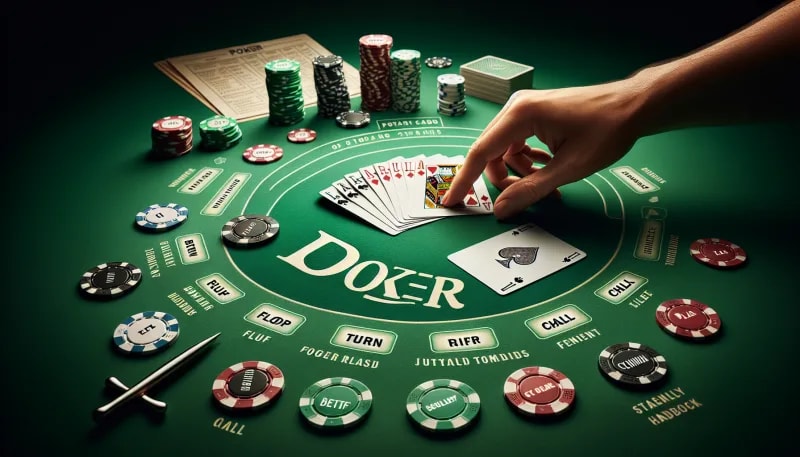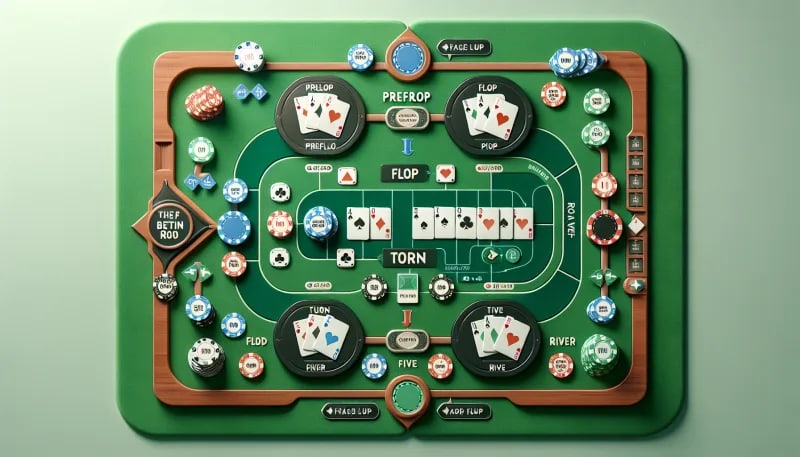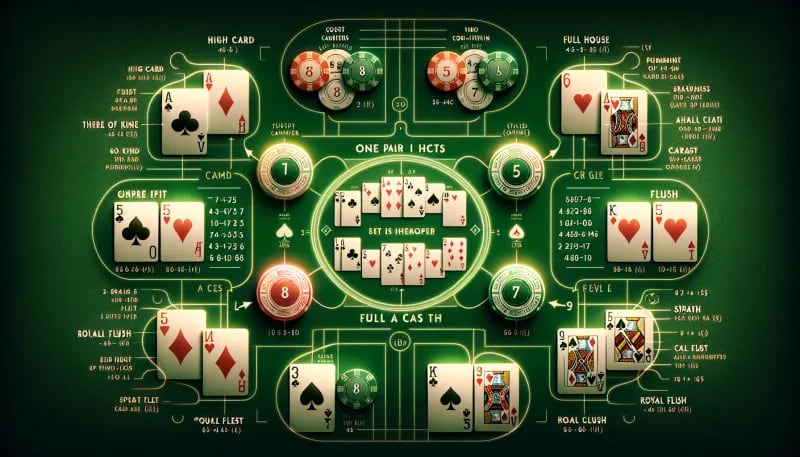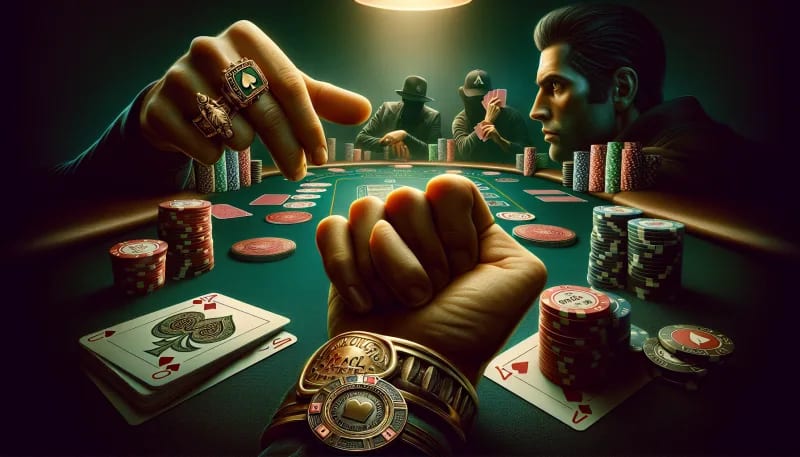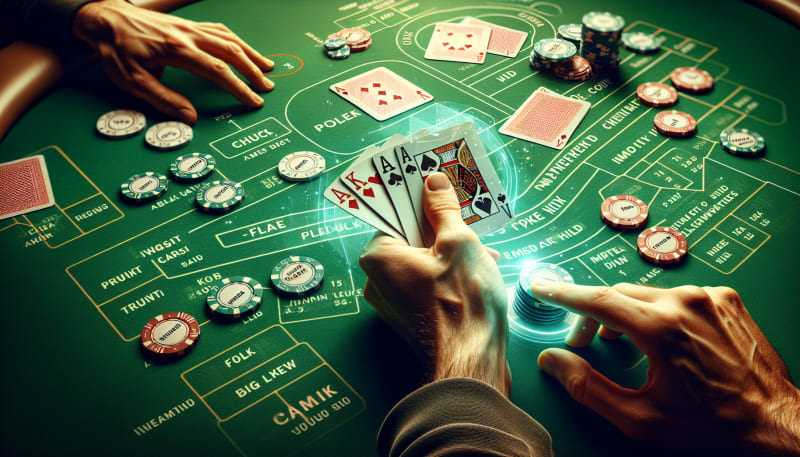Poker Terms 101: Essential Guide for Beginners
Introduction to Poker Terminology
So you've decided to dive into the captivating world of poker, right? Well, hold your horses. Before you can start making strategic bluffs or reading your opponents, there's a fundamental step you can't skip: understanding poker terminology. I'm not just talking about learning a few fancy words to impress your buddies; I mean really grasping the lingo.
Why, you ask? Because, in poker, knowledge is power – and every term is a building block in your fortress of strategy. For instance, knowing what a "gutshot" is could be the difference between calling a bet or folding in terror. Sounds critical, doesn't it?
Part of poker's beauty lies in its language – a unique jargon that can seem like a code to outsiders but acts like a secret handshake for those who know it. Ever sat at a poker table and felt lost while others seemed to be speaking a different language? Don't worry, I've been there. But once you get the terminology down, you’ll feel like you've been let in on one of the greatest secrets of the game.
Learning the terms isn’t just about following along; it's about unlocking a deeper understanding of the game's mechanics. Peek at this: when you know your range from your river, you're better positioned to predict what your opponents might hold. And prediction, my friends, is where the real game is at.
Ready to ante up? Great. Stick with me, and soon you'll be slinging poker slang with the best of them. Next up, we'll move beyond the talk and into the action in 'The Basics: Checking, Betting, Folding' — where your newfound knowledge will start shaping your gameplay. Ready to transform those words into wins? Let's shuffle up and deal with the world of poker lingo.
The Basics: Checking, Betting, Folding
Coming off our 'Introduction to Poker Terminology,' we're diving straight into the core actions you'll be taking at the table. Let's start with checking. Picture this: The action's on you, and you're feeling neither hot nor cold about your hand. What do you do? You check. It's essentially hitting the pause button on betting - passing the action to the next player without upping the ante.
Now imagine your hand's looking strong. You've got that twinkle in your eye, ready to swoop the pot. Here's where you make your move and bet. Initiating a bet opens the field. Others must now decide if they're in or out. They can fold, call or raise — all terms we'll dissect in a moment.
Speaking of folding, ever find yourself in a spot where your cards are a highway to nowhere? That's when you fold. You're bowing out gracefully, or not so gracefully, from the current hand. Keep your chips for another battle. It's about picking your fights wisely, wouldn't you agree?
Now, let's say someone has bet before the action gets to you. If your hand isn't screaming "winner!" but it's too good to muck, you might choose to simply call — matching the current bet and staying in the game. If your hand makes you feel like a villain in a Bond movie, brazen and powerful, you could raise — increasing the stakes and putting pressure on your opponents.
Remember, whether you check, bet, or fold significantly alters the dynamic of the hand. And how these actions tie into the betting rounds? That's a crucial link. As we segue into 'Navigating the Betting Rounds,' keep in mind the strategic domino effect of your choices. Every move sends ripples through the game. So ask yourself: How can you turn the tide in your favor?
Navigating the Betting Rounds
As we’ve uncovered the foundational actions of checking, betting, and folding, it's clear that timing is everything. But, how does this play out through the phases of a hand? Let’s break it down.
Preflop is where the drama begins. Each player has their hole cards, but who has the upper hand? I gauge my opponents. Are they timid or aggressive? Adjusting my strategy starts here.
I ponder a crucial question: To raise or not to raise? Aggression can pay off, but caution has its merits. What's your move?
The flop is a game-changer, literally. With three community cards on the board, the poker landscape alters. Here's where I craft my narrative. Do I represent strength or bide my time?
My approach? Observe meticulously. A tight player’s bet could spell strength, while a loose cannon could be bluffing. Adjust accordingly.
Come the turn, the plot thickens. With the fourth card down, my poker tale is nearing its climax. This is often where big bets come into play. Pot odds are crucial, and so is reading the table. Is your opponent on a draw, or have they made their hand?
I ask myself: How does this card change things? It's a moment for calculated risks or strategic retreats.
Finally, the river—the reveal that can crown kings or crush dreams. The last betting round requires nerves of steel. It’s pivotal in concluding the narrative you’ve spun.
I focus on consistency. If I’ve shown strength, do I follow through? The answer hinges on the tale told thus far. Remember, it’s not just about the cards. It’s about the story they tell.
With the basics under your belt, you’re ready to interpret the tale of the Hand Rankings and Combos. Are you prepared to turn the raw data of your hand into a winning story? Let’s find out.
Hand Rankings and Combos
After mastering betting rounds, it's time to delve into the core of poker — understanding hand rankings. I mean, what’s the use of betting if you don’t know what you’re holding, right? Starting at the bottom, the simplest hand is a High Card. No combos here, just the highest card in your hand.
But things get more interesting with One Pair. It's two cards of the same rank and happens quite often. Then there’s Two Pair, unsurprisingly, two different pairs. Moving up, Three of a Kind squares off as a solid hand, with three cards of matching rank.
Strategically speaking, isn't it thrilling when sequences come into play? You nod to the sequence of consecutive cards with a Straight. Feeling a rush when you see all cards in sequential order, don't you?
Color coordination happens with a Flush. All your cards are dressed in the same suit. The combo of Full House — a pairing of a Three of a Kind with One Pair, brings excitement to the table. Then, Four of a Kind wallops with four identical rank cards. A Straight Flush — the marriage between a Straight and a Flush, has your heart racing for sure.
Now, the elusive Royal Flush. The apex of poker mountains. It's a Straight Flush but with the highest possible cards: Ten to Ace. A beacon of rarity.
Understanding these rankings is not just crucial, it's the backbone of your strategy. But what about those specific hand combinations? Ah, let me give you the inside scoop.
Ever heard of Pocket Aces? That's two Aces in your hole cards. A powerhouse, but keep a poker face! And what about Suited Connectors? These are sequential cards of the same suit. They hold potential, don't they? Stealthy draws can emerge, veiling your hand’s strength.
The knowledge of these combinations equips you with a crucial foresight. Can you foresee how that pairs with the 'Player Actions and Tells' part? Knowing these hands, can you spot the bluff, or will you be the architect of deception? Stay keen, my friends. Your poker prowess depends on it.
Player Actions and Tells
Understanding hand rankings and combos is crucial, but navigating the psychological labyrinth of poker demands mastery over player actions and tells. How does one make use of this knowledge? Let's dive in.
When I talk about 'bluffing,' I'm referring to playing a weak hand with unflinching confidence to deceive opponents. It’s a daring risk, but pulling off a successful bluff can swing a game in your favor. Observing the subtle cues or tells of opponents trying to bluff is equally important.
Next, consider a 'raise.' It’s an increment of the bet, signaling a strong hand or another strategic bluff. A timely raise can intimidate and stir chaos in the minds of other players. However, a misplaced raise can be a costly error. So, when I spot a raise from an opponent, I immediately try to gauge whether they're overconfident or sitting on a potential monster hand.
Going 'all-in' is when a player wagers all their chips. It's the ultimate declaration of confidence (or desperation). An all-in can drastically alter the dynamics of the game.
Now, what about behavior and psychology? A 'tell' is any change in a player's behavior or demeanor that gives clues about their hand. I keep a lookout for these, as they can divulge whether a player is stressed, elated, or trying to mislead others.
'Tilt,' on the other hand, describes a player's frustration leading to reckless decisions. Ever seen someone act erratically after a bad beat? That's tilt. Avoiding tilt is essential for rational decision-making.
Recognize these actions or tells on the felt, and you harness the power to read the unspoken. Practice observing closely, because the subtlest of gestures – a twitch, a glance, a sigh – might just reveal the secrets you need.
This psychological play intricately connects to the next part of our article: Pot Odds and Expected Value. Whereas actions and tells help read the present, understanding odds and value will sharpen your foresight, molding you into a formidable player who makes decisions rooted in math as well as intuition.
Pot Odds and Expected Value
Understanding pot odds and expected value is like having a secret weapon at the poker table. After getting a grasp of player actions and tells, these concepts help provide the critical mathematical aspect of the game, guiding us toward smarter decisions.
So, what exactly are pot odds? They are the ratio of the current size of the pot to the cost of a contemplated call. Imagine the pot's at $100, and you need to call $20. Your pot odds are 5 to 1. Is it worth staying in? That's where pot odds shine, giving you a clearer picture.
But pot odds aren't much without their trusty sidekick: expected value or EV. It tells us what we can expect to win or lose on average from a bet over the long run. Calculating EV may initially sound daunting, doesn't it? But hang tight — it's a game-changer.
EV combines the odds of winning with the amount we could win against the odds of losing and the amount at stake. Positive EV suggests a bet will be profitable over time. Negative EV, however, is a warning sign that it’s likely a losing proposition.
Incorporating pot odds and EV into your strategy is like laying a solid foundation before building a house. Think of pot odds as assessing the price of the plot, and EV as calculating the potential return on investment.
As we transition to Advanced Poker Concepts, remember this: Mastery of pot odds and expected value isn’t just number crunching. It’s an essential layer to understanding the deep strategy of poker, making your gameplay not just about luck, but a meticulous well-thought plan. Shall we raise the stakes in the next section?
Advanced Poker Concepts
Now that we've wrapped our heads around pot odds and expected value, it's time to dive deeper. Implied odds are like the sly cousin of pot odds. They're not just about what's in the pot right now, but also about what could be won on later streets. How much more will you win if you hit your draw? That's the real question. Understanding implied odds means you’re betting on the future, not just the present.
Then there's range. No, we're not talking about kitchen appliances here. A player's range is the collection of all hands they could plausibly hold in a given situation. Why limit yourself to guessing single hands? I don’t, and neither should you. By thinking in terms of ranges, we're several steps ahead, analyzing probabilities instead of hunches. That's real power.
Let's not forget about fold equity. It's all about applying pressure. When I push chips into the middle, it's not just the current pot I'm after. It’s also the chance that my opponent will fold, awarding me the pot without a showdown. Fold equity quantifies this non-zero chance into our strategy. It helps us decide when to bluff or push an opponent off a marginal hand.
Now, why do these concepts matter? Because poker isn't a game of chance; it's a nuanced battle of wits. Master these advanced terms, and suddenly, you're not just playing the cards—you're playing the player. You're reading situations with a sharper eye and betting with an informed edge.
Think you're ready for this level of play? Imagine wielding these concepts with ease, weaving them through your game like a seasoned pro. Stay tuned for the next section, where I'll show you how to incorporate your new vocabulary into real-life gameplay. It's time to turn these concepts from mere words into cold, hard chips sliding your way.
Applying Your Poker Vocabulary
Let's dive right in. You've got a shiny glossary of poker terms from our 'Advanced Poker Concepts' section, and you're itching to use them. How do you actually fold them into your game?
First, practice makes perfect. There's no substitute for live play when it comes to testing out your new lingo. Find low-stakes games where you can comfortably throw around terms like three-bet, squeeze play, or c-bet without fear of costly mistakes.
Don't just memorize words; understand them. Can you explain what a float is? Or when you might 4-bet? Knowing these intimately means you're not just talking the talk, you're ready to walk the walk.
Use the language in context. During a hand, think: "Is this a good spot for a continuation bet?" If you're stumped, that's okay. Post-game analysis helps too. Reflect on your decisions and consider if there were betting lines you missed. Could you have value bet more effectively on the river?
Interact with others. Are you part of an online community forum yet? Engage with fellow enthusiasts who are just as keen on polishing their poker patois. It will reinforce your knowledge and could lead to insightful discussions.
Ever watched a final table live stream? Do it. Listen to the commentators banter. They frequently dissect players' decisions using the very vocabulary you're learning. It's a great way to see the terms in action, providing real-life context that enhances understanding.
Remember this: vocabulary is not just about showing off your poker prowess. It's an essential part of strategic play. It clarifies your thought process, aids communication, and, honestly, it's part of poker's charm.
So, go ahead. Mix it up at the tables. Drop a check-raise here, a double-gutted straight draw there. Be fearless. Be strategic. But most importantly, keep learning and keep playing.
And who knows? Maybe your fluency in poker jargon will have you reading opponents like a pro in no time. See you at the tables, and in the forums!

